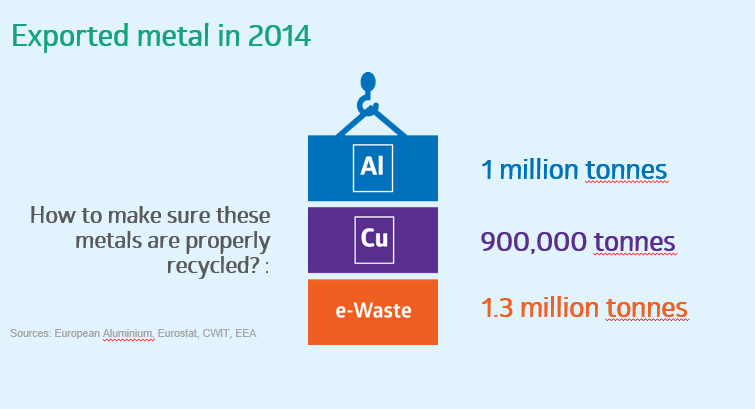Instead of turning scrap metal and end-of-life products into a resource as part of the circular economy, Europe exports far too much abroad to places where environmental and health protection is not guaranteed. We explain here how policymakers can fundamentally change this dynamic with the EU’s waste proposals.
Metals on the move
In 2014, Europe exported almost 2 million tonnes of scrap metal including aluminium and copper, as well as 1.3 million tonnes of electronic waste. Export levels have steadily increased for over a decade. Why?
The answer is simple. Scrap metals and products have significant economic value, making them a hot commodity abroad. High-quality European recyclers can be disadvantaged in this competitive global market, due to their leading standards in environment, health and safety protection, on top of high energy. transport and labour costs. The EU internal waste market is also not yet a reality.
At the same time, there’s no guarantee that our exported metal gets properly recovered, by facilities with efficient processes and equivalent environmental standards. Poor recycling practices result in fewer recovered metals, damage to the environment and risks to workers. We’ve got to change this dynamic to achieve a true circular economy.

Make the rules the same for all
Global competition for scrap is healthy, but only when the rules of the game are the same. That’s why we’re calling on policymakers to ensure that all exported European waste gets treated under “equivalent conditions”,and to fight against illegal exports.
It doesn’t have to be complex. Environment, health and safety standards are already there for some waste streams such as aluminium and copper scrap, and EU process standards are about to be finalised for treating electronic waste. To count towards EU recycling targets, waste exports should need to be recycled to this level.
We cannot overstate the importance of this reform for European growth and the environment. If high-quality European recyclers could recycle the different metals being exported, Europe’s production of recycled metals would rise significantly.
Take aluminium. On top of increasing recycling rates by 10%, we’d also save the equivalent of Latvia or Luxembourg’s entire energy consumption, from not having to produce new metal from scratch.
Start with the waste proposal
Policymakers are debating the European Commission’s waste proposals right now in the halls of the European Parliament and in Member States. We have specific and realistic proposals to turn Europe’s metal waste into a resource that supports European growth AND protects the environment:
- Improve collection and sorting systems in Europe to enhance the availability of secondary raw materials
- Make exported waste only countable towards EU recycling targets when treated under “equivalent conditions”. To define these conditions, refer to existing environmental, health and safety standards through an implementing act/
- For complex waste streams, such as e-Waste and portable batteries, introduce a certification scheme based on relevant process standards, to guarantee that hazardous and critical materials are properly treated
The benefits of this approach are twofold. Firstly, high-quality European recyclers will be less disadvantaged against international competitors not meeting the same high standards. Secondly, we can all fulfil our responsibility to keep Europe’s valuable resources within the loop.
Check out our position paper for full details on how to make this happen.
System.NullReferenceException: Object reference not set to an instance of an object. at Umbraco.Core.Models.PublishedContent.PublishedContentType..ctor(IContentTypeComposition contentType, IPublishedContentTypeFactory factory) in D:\a\1\s\src\Umbraco.Core\Models\PublishedContent\PublishedContentType.cs:line 23 at Our.Umbraco.DocTypeGridEditor.Helpers.DocTypeGridEditorHelper.<>c__DisplayClass3_0.<GetContentTypesByAlias>b__0() at Umbraco.Core.Cache.AppCacheExtensions.<>c__DisplayClass5_0`1.<GetCacheItem>b__0() in D:\a\1\s\src\Umbraco.Core\Cache\AppCacheExtensions.cs:line 62 at Umbraco.Core.Cache.FastDictionaryAppCacheBase.<>c__DisplayClass21_0.<GetSafeLazy>b__0() in D:\a\1\s\src\Umbraco.Core\Cache\FastDictionaryAppCacheBase.cs:line 285 --- End of stack trace from previous location where exception was thrown --- at System.Runtime.ExceptionServices.ExceptionDispatchInfo.Throw() at Umbraco.Core.Cache.WebCachingAppCache.GetInternal(String key, Func`1 factory, Nullable`1 timeout, Boolean isSliding, CacheItemPriority priority, CacheItemRemovedCallback removedCallback, String[] dependentFiles) in D:\a\1\s\src\Umbraco.Core\Cache\WebCachingAppCache.cs:line 174 at Umbraco.Core.Cache.WebCachingAppCache.Get(String key, Func`1 factory) in D:\a\1\s\src\Umbraco.Core\Cache\WebCachingAppCache.cs:line 34 at Umbraco.Core.Cache.DeepCloneAppCache.Get(String key, Func`1 factory) at Umbraco.Core.Cache.AppCacheExtensions.GetCacheItem[T](IAppCache provider, String cacheKey, Func`1 getCacheItem) in D:\a\1\s\src\Umbraco.Core\Cache\AppCacheExtensions.cs:line 62 at Our.Umbraco.DocTypeGridEditor.Helpers.DocTypeGridEditorHelper.GetContentTypesByAlias(String contentTypeAlias) at Our.Umbraco.DocTypeGridEditor.Helpers.DocTypeGridEditorHelper.ConvertValue(String id, String contentTypeAlias, String dataJson) at Umbraco.Core.Cache.AppCacheExtensions.<>c__DisplayClass5_0`1.<GetCacheItem>b__0() in D:\a\1\s\src\Umbraco.Core\Cache\AppCacheExtensions.cs:line 62 at Umbraco.Core.Cache.FastDictionaryAppCacheBase.<>c__DisplayClass21_0.<GetSafeLazy>b__0() in D:\a\1\s\src\Umbraco.Core\Cache\FastDictionaryAppCacheBase.cs:line 285 --- End of stack trace from previous location where exception was thrown --- at System.Runtime.ExceptionServices.ExceptionDispatchInfo.Throw() at Umbraco.Core.Cache.HttpRequestAppCache.Get(String key, Func`1 factory) in D:\a\1\s\src\Umbraco.Core\Cache\HttpRequestAppCache.cs:line 81 at Umbraco.Core.Cache.AppCacheExtensions.GetCacheItem[T](IAppCache provider, String cacheKey, Func`1 getCacheItem) in D:\a\1\s\src\Umbraco.Core\Cache\AppCacheExtensions.cs:line 62 at ASP._Page_app_plugins_doctypegrideditor_render_DocTypeGridEditor_cshtml.Execute() in c:\inetpub\wwwroot\v8.eurometaux.eu\App_Plugins\DocTypeGridEditor\Render\DocTypeGridEditor.cshtml:line 26 at System.Web.WebPages.WebPageBase.ExecutePageHierarchy() at System.Web.Mvc.WebViewPage.ExecutePageHierarchy() at System.Web.WebPages.WebPageBase.ExecutePageHierarchy(WebPageContext pageContext, TextWriter writer, WebPageRenderingBase startPage) at Umbraco.Web.Mvc.ProfilingView.Render(ViewContext viewContext, TextWriter writer) in D:\a\1\s\src\Umbraco.Web\Mvc\ProfilingView.cs:line 25 at System.Web.Mvc.Html.PartialExtensions.Partial(HtmlHelper htmlHelper, String partialViewName, Object model, ViewDataDictionary viewData) at ASP._Page_Views_Partials_grid_editors_Base_cshtml.Execute() in c:\inetpub\wwwroot\v8.eurometaux.eu\Views\Partials\Grid\Editors\Base.cshtml:line 20